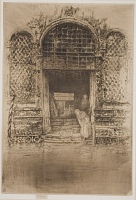Etchings Institutions search term: grolier club
The Doorway | ||
| Number: | 193 | |
| Date: | 1879/1880 | |
| Medium: | etching, drypoint and roulette | |
| Size: | 295 x 204 mm | |
| Signed: | butterfly at upper left | |
| Inscribed: | no | |
| Set/Publication: | 'First Venice Set', 1880 | |
| No. of States: | 20 | |
| Known impressions: | 66 | |
| Catalogues: | K.188; M.185; W.154 | |
| Impressions taken from this plate (66) | ||
TECHNIQUE
11: Wedmore 1886 A (cat. no. 154).
12: 'Mr. Whistler's etchings ...', British Architect, 10 December 1880 (GUL PC4/19).
PRINTING
The first eight states were printed between 1880 and 1881. They include impressions in black ink on ivory laid paper (
 ); on ivory laid with Arms of Amsterdam watermark (
); on ivory laid with Arms of Amsterdam watermark ( ); buff wove (
); buff wove ( ); cream laid paper with Pro Patria watermark (
); cream laid paper with Pro Patria watermark ( ). Of the seventh state, one is in dark brown ink on Japanese paper (
). Of the seventh state, one is in dark brown ink on Japanese paper ( ) and one in black on ivory Japan (
) and one in black on ivory Japan ( ), while others are in black ink on western papers, both ivory wove (
), while others are in black ink on western papers, both ivory wove ( ) and laid (
) and laid ( ). Eighth state impressions are also in dark brown but mostly in black ink (i.e.
). Eighth state impressions are also in dark brown but mostly in black ink (i.e.  ).
). ) and western (
) and western ( ) laid papers. Deliveries were rare thereafter; he sent three on 13 January 1887, twelve on 25 June 1887, and the same again on 2 April 1889. 14 A large group of impressions of the 14th state may date from 1887. They were mostly printed in dark brown ink on laid paper in shades of ivory, cream, off-white and buff, one with a 'WW' countermark (
) laid papers. Deliveries were rare thereafter; he sent three on 13 January 1887, twelve on 25 June 1887, and the same again on 2 April 1889. 14 A large group of impressions of the 14th state may date from 1887. They were mostly printed in dark brown ink on laid paper in shades of ivory, cream, off-white and buff, one with a 'WW' countermark ( ) and another with the watermark 'FELLOWS / 1804' (
) and another with the watermark 'FELLOWS / 1804' ( ) but some were on ivory Japanese (
) but some were on ivory Japanese ( ,
,  ).
). 17: Whistler to Huish, 3 July 1892, GUW #02969.
 ) which was priced, according to a note on the verso, at '21 guineas' (£22.1.0) and is now in the Hamburger Kunsthalle. Other dramatic impressions of the final state were printed in black ink on translucent Japanese paper (
) which was priced, according to a note on the verso, at '21 guineas' (£22.1.0) and is now in the Hamburger Kunsthalle. Other dramatic impressions of the final state were printed in black ink on translucent Japanese paper ( ,
,  ). However, Whistler worried about the condition of the copper plates at this late date:
). However, Whistler worried about the condition of the copper plates at this late date:
22: Whistler to Huish, [14 August 1894], GUW #01277.
24: Huish to R. B. Philip, 1 Aug., 14 Sept., 22 and 29 Oct., 13 Nov., 3, 12, 14 and 17 Dec. 1903, GUL F323-4, 326; Philip to Huish, 15 Sept., 26 Oct., 18 Dec. 1903, GUL P485, F327-31, F333-35; MacDonald 2001 , pp. 132-133.
25: Letter book Whistler LB6/261, Glasgow University Library.


